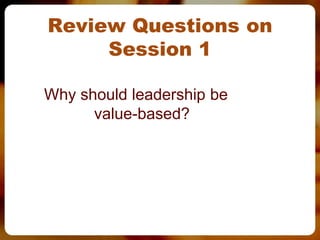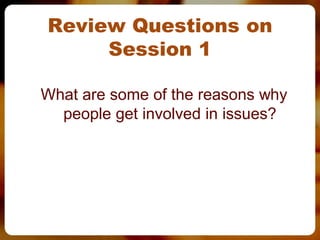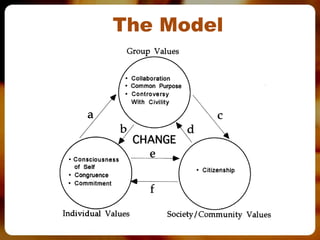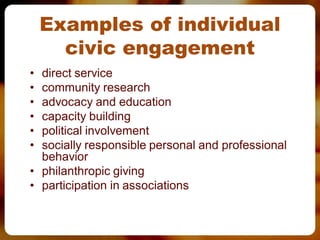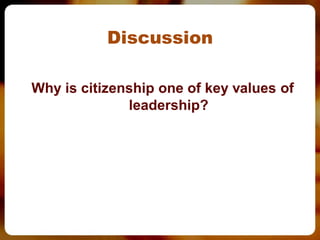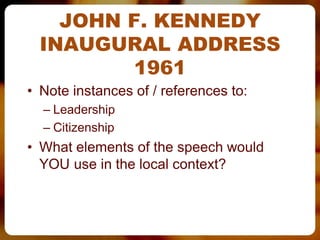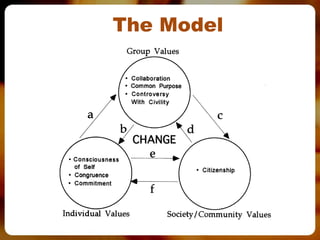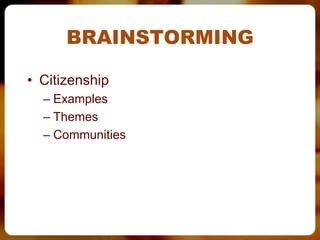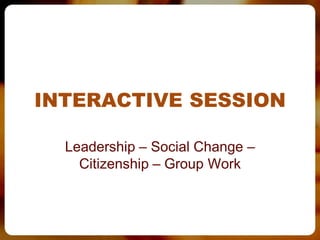Session 2 citizenship
- 3. Review Questions on Session 1 • Are lectures enough to develop leadership? Would reading books on leadership suffice? What else do we need?
- 4. Kolb Model
- 5. Review Questions on Session 1 • Why do we need a log book?
- 6. Review Questions on Session 1 • What are the five levels of leadership identified by Maxwell?
- 7. 5 levels of Leadership I. Position: Rights - People follow you because they have to. II. Permission: Relationships - People follow because they want to. III. Production: Results - People follow because of what you have done for the country/ organization / team. IV. People Development: Reproduction - People follow because of what you have done for them. V. Personhood: Respect - People follow because of who you are and what you represent.
- 8. Review Questions on Session 1 “If leaders are to be successful, they must first lead themselves.” (John Maxwell) What does this imply?
- 9. Review Questions on Session 1 Why should leadership be value-based?
- 10. Review Questions on Session 1 ‘Change is the ultimate goal of the creative process of leadership’ – Discuss
- 11. Review Questions on Session 1 Attitude = Leadership ?
- 12. Review Questions on Session 1 How do the media ‘create’ leaders?
- 13. Review Questions on Session 1 How is real social change different from charity?
- 14. Review Questions on Session 1 What are some of the reasons why people get involved in issues?
- 15. Review Questions on Session 1 What are the differences between Burns’s ‘transactional leadership’ and ‘transforming leadership’? Which one should we go for? Why?
- 16. James MacGregor Burns • Transactional leadership: power wielders (‘pseudo leaders’) involved in a politics of exchange – more interested in satisfying their own purposes than in the aspirations of their followers
- 17. James MacGregor Burns • Transforming leadership espouses a relationship between leaders and followers in which each transforms the other. – Leaders transform followers, helping them to become leaders themselves – The aim of leadership • not just to reach a goal • but to transform leaders and followers into better, more self- actualized people • in a process where leaders and followers raise one another to higher levels of motivation and morality
- 18. Review Questions on Session 1 Where would ‘transforming leadership’ be located on Maxwell’s 5-level scale?
- 19. 5 levels of Leadership I. Position: Rights - People follow you because they have to. II. Permission: Relationships - People follow because they want to. III. Production: Results - People follow because of what you have done for the organization/team. IV. People Development: Reproduction - People follow because of what you have done for them. V. Personhood: Respect - People follow because of who you are and what you represent.
- 20. Differences between Management and Leadership? –
- 21. Managers Leaders Deal with status quo Initiate change Work in the system Create systems React Create opportunities Control risks Innovate Enforce rules Formulate new rules Seek / follow directions Provide vision / direction Control people Motivate people Coordinate activities Energise / inspire people Give instructions Coach, create self-leaders
- 22. Review Questions on Session 1 • Change, if any, in our understanding of leadership? • How will this change in understanding affect our future behaviour as leaders?
- 23. Session 2
- 24. Objectives of Session 2 • By the end of this session participants will be able to demonstrate a clear understanding of the following concepts as they apply to leadership in the Social Change Model (SCM) – Citizenship – Community – Social capital – Bonding – Bridging
- 25. The Model
- 27. Citizenship • Citizenship is a nebulous concept, often associated only with government, political parties, voting, and political organizations. • Civic engagement means working to make a difference in the civic life of our communities and developing the combination of knowledge, skills and values and motivation to make that difference • Democracy refers to people working together so that communities can function
- 28. Citizenship • Citizenship names the process whereby the self is responsibly connected to the environment and the community. It acknowledges the interdependence of all involved in the leadership effort. • Citizenship means more than membership; it implies active engagement of the individual and the leadership group in an effort to serve the community. It implies social or civic responsibility. • It is, in short, the value of caring about others.
- 29. Community • A community is a group of people who have some defined trait or circumstance that binds them together • So we are likely a member of a variety of communities: our country, our family, our university, our field of study, our work group, and so on
- 30. Community • According to the Social Change Model, citizenship “centers on active community participation as a result of a sense of responsibility to the communities in which we live.”
- 31. Examples of individual civic engagement • direct service • community research • advocacy and education • capacity building • political involvement • socially responsible personal and professional behavior • philanthropic giving • participation in associations
- 32. Social Capital • An essential component of citizenship – “networks, norms, and social trust that facilitate coordination and cooperation for mutual benefit” (Robert Putnam) • ‘Life is easier’ for those who live in communities that have worked to foster social capital
- 33. Discussion • Can you think of cases of destruction of communities and the consequences thereof?
- 34. “Bonding” and “Bridging” • Social capital is about the value of social networks, bonding similar people and bridging between diverse people, with norms of reciprocity. • Bonding refers to social networks between people who are similar, while bridging refers to social networks among diverse people • Bonding is useful for getting by and bridging is what is needed to get ahead
- 35. Community development process 1. Pseudo-community (a false sense of getting along), 2. Chaos (unconstructive struggle), 3. Budding organization (focus on quick fixes), 4. Community (strategies exist for allowing various voices to be heard and ideas to be considered)
- 36. Recap • Citizenship – The Social Change Model defines citizenship as, “active community participation as a result of a sense of responsibility to the communities in which people live.” • Community – various dimensions include where a group of people live, society at large, and shared identities with others • Social capital – “networks, norms, and social trust that facilitate coordination and cooperation for mutual benefit” • Bonding – refers to social networks that are limited to people who are similar • Bridging – social networks among more diverse people and interests
- 37. Discussion Why is citizenship one of key values of leadership?
- 38. VIDEO http://www.youtube.com/watch?v=BLmiOEk59n8 TEXT: http://www.bartleby.com/124/pres56.html
- 39. JOHN F. KENNEDY INAUGURAL ADDRESS 1961 • Note instances of / references to: – Leadership – Citizenship • What elements of the speech would YOU use in the local context?
- 40. JFK SPEECH (1/3) • from this time and place • to a new generation of Americans • we shall pay any price • Divided there is little we can do • …help them help themselves…because it is right • civility is not a sign of weakness
- 41. JFK SPEECH (2/3) • explore what problems unite us • All this will not be finished in the first one hundred days…But let us begin • Will you join in that historic effort? • I do not shrink from this responsibility, I welcome it. • ask of us here the same high standards of strength and sacrifice which we ask of you
- 42. JFK SPEECH (3/3) • ask not what your country can do for you; ask what you can do for your country
- 43. The Model
- 44. BRAINSTORMING!
- 45. BRAINSTORMING • Citizenship – Examples – Themes – Communities
- 47. INTERACTIVE SESSION Leadership – Social Change – Citizenship – Group Work
- 48. The Model
- 49. Community Value Citizenship Believing in a process whereby an individual and/or group become responsibly connected to the community and to society through some activity. Recognizing individuals and groups have responsibility for the welfare of others.
- 50. Group Values • Collaboration: – Working with others in a common effort, sharing responsibility, authority, and accountability. • Common Purpose: – Having shared aims and values. Involving others in building a group’s vision and purpose. • Controversy with Civility: – Recognizing 2 fundamental realities of any creative group effort • 1) differences in viewpoint are inevitable • 2) such differences must be aired openly but with civility.
- 51. Individual Values • Consciousness of self: – being self-aware of the beliefs, values, attitudes and emotions that motivate you to take action. • Congruence: – Acting in ways that are consistent your values and beliefs. • Commitment: – Having significant investment in an idea or person, both in terms of intensity and duration.
- 52. DISCUSSION








